Be an Upstander: Sadie Jacobs Crockin
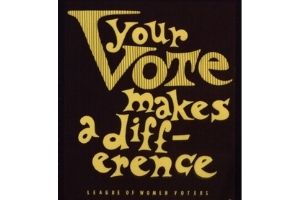
Last week, we shared our newly online The A-Mazing Mendes Cohen exhibit, which allows us to revisit the story of this extraordinary Baltimorean with even more people. Inspired by this exhibit, and by the ongoing theme of voter education, I wanted to return to the story of Sadie Jacobs Crockin.
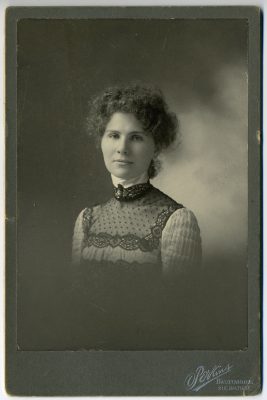
JMM featured Crockin back in 2010, in a pop-up exhibit in our lobby called VOTE! The Life and Work of Sadie Jacobs Crockin, to commemorate the 90th anniversary of the League of Women Voters. This exhibit went on to travel to various local organizations as a part of the celebrations. It’s fitting to revisit Sadie and her story today, as we celebrate the 100th year anniversary of the League, as well as women’s right to vote, with the ratification of the nineteenth amendment in 1920. And we’ll be celebrating later this year with a new exhibit dedicated to her life! While we don’t have an entire website available as a resource about the exhibit, I wanted to share the central story of Crockin’s life, and some ways we can honor her work and the work of women as they fought for their right to choose their leaders.
Sadie Jacobs was born in Baltimore in 1879 and grew up in Virginia, where she also attended college at Randolph-Macon College. She joined the first generation of women to attend college in the US, and she clearly made her mark during her time there. She was even awarded “Best Address” for her graduation speech, for which she received this gold medallion.

Clearly, Sadie had a talent for speaking and leading people. She returned to Baltimore after marrying Emil Crockin and lived on Park Heights Avenue until he passed in 1943. Thanks to Emil’s success as a clothing manufacturer, eventually becoming the owner of Wearwell Clothing Company, Sadie had the freedom and ability to pursue her own interests in education and philanthropy and was especially interested in helping immigrants to adapt to American life. She even taught night classes in English as a second language for immigrant women, much like Henrietta Szold. Indeed, over the course of Crockin’s life, she and Szold were friendly enough that Szold sent her a telegram, wishing her happiness upon the occasion of her daughter’s marriage.
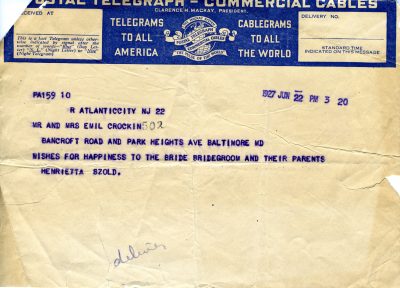
Crockin even helped to form the Baltimore Chapter of Hadassah, of which the national organization Szold created, and served as President for its first 15 years. Her skills in leadership and public speaking lent themselves to this role, and she was a defining character in the development of the Baltimore Hadassah Chapter, which is still going strong today. During the VOTE! exhibit we featured some of Sadie’s belongings from this time, such as a notebook she used to draft speeches and keep meeting agendas.

Crockin was also elected to represent Baltimore at the first American Jewish Congress, in 1918. She gave an oral report on the event, and her experience speaks to her intelligence and curiosity, as she talked about the diversity of the delegates and the historical proceedings. And her position as a leader in the community is demonstrated by her role in attending.
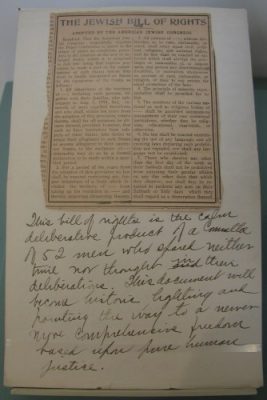
Beyond her work in Hadassah, Sadie saw the importance of teaching people about their civic duty: voting. With the passage of the nineteenth amendment, suffragist leaders organized the League of Women Voters (or LWV), to encourage women to vote and to educate them before they stepped into the ballot box. Crockin was inspired by the first League President, Maud Wood Park, when Crockin attended an address of hers. Crockin decided to step forward to lead the Baltimore chapter of the League, despite her other various responsibilities.

LWV Baltimore is still very active, working to inform people of their voting rights, and engages in advocacy over public policy legislation. It’s clear that Sadie’s leadership has had an impact on the organization, as they continue to work towards education and helping others. During her time serving as president, LWV regularly recognized how important Crockin was to the organization, including when she retired from her role in 1930.
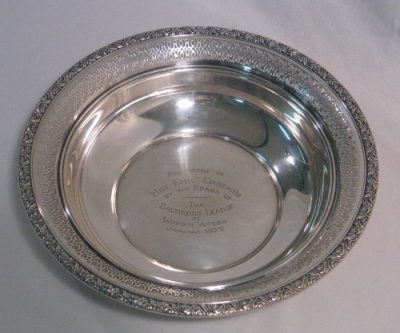
Throughout her life, Sadie continued her advocacy work, always focused on helping others to find education and dignity. Her legacy continues today, as we plan to display another exhibit about her life this year, curated by our Director of Programs and Visitor Services, Trillion Attwood. Stay on the lookout for the opening dates!
In the meantime, help us honor Sadie’s life and work by practicing your own civic duty. Make sure you vote in any upcoming elections, such as the Baltimore Mayor and Special Maryland District 7 elections. Check your State Board of Elections for more information about upcoming elections, and visit our previous blog post to learn how to educate yourself before you step into the booth.
We thank Sadie Jacobs Crockin, and all the women who worked to ensure that women have the right to vote. We also recognize all the people who continue to work today, to ensure that our rights are not taken from us.
